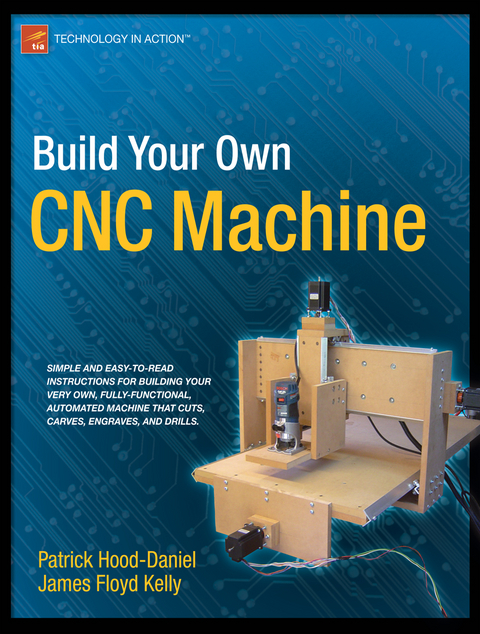
Build Your Own CNC Machine
Apress (Verlag)
978-1-4302-2489-1 (ISBN)
Do you like to build things? Are you ever frustrated at having to compromise your designs to fit whatever parts happen to be available? Would you like to fabricate your own parts? Build Your Own CNC Machine is the book to get you started. CNC expert Patrick Hood-Daniel and best-selling author James Kelly team up to show you how to construct your very own CNC machine. Then they go on to show you how to use it, how to document your designs in computer-aided design (CAD) programs, and how to output your designs as specifications and tool paths that feed into the CNC machine, controlling it as it builds whatever parts your imagination can dream up.
Don't be intimidated by abbreviations like CNC and terms like computer-aided design. Patrick and James have chosen a CNC-machine design that is simple to fabricate. You need only basic woodworking skills and a budget of perhaps $500 to $1,000 to spend on the wood, a router, and various other parts that you'll need. With some patience and some follow-through, you'll soon be up and running with a really fun machine that'll unleash your creativity and turn your imagination into physical reality.
The authors go on to show you how to test your machine, including configuring the software.
Provides links for learning how to design and mill whatever you can dream up
The perfect parent/child project that is also suitable for scouting groups, clubs, school shop classes, and other organizations that benefit from projects that foster skills development and teamwork
No unusual tools needed beyond a circular saw and what you likely already have in your home toolbox
Teaches you to design and mill your very own wooden and aluminum parts, toys, gadgets—whatever you can dream up
James Floyd Kelly is a professional writer from Atlanta, Georgia. He has written numerous books on multiple subjects, including LEGO robotics, open source software, and building your own CNC machine as well as a 3D printer. He is the editor-in-chief of the number one MINDSTORMS NXT blog, The NXT Step (TheNXTStep.com), where he is joined by fellow NXT experts who share their knowledge and designs with other robot fans around the world.
Introduction.- PART I CNC Basics.- Chapter 1 What is CNC?.- Description and CNC defined including the some history. This also might be a good place for the various types of CNC machines.- Chapter 2 DIY-CNC Project Overview Description of the project, tools required and safety. Will include computer requirements.- Chapter 3 Cutting the parts describes the parts layout and special instructions for cutting.- Special instructions for labeling parts for use in later chapters.- PART II The DIY-CNC Machine Chapter 4 - Linear Movement.- Creating the fundamental mechanism for movement with bearings and rails. The reinforcing concept behind this design would be included.- Chapter 5 - Motion transmission.- The translation from circular motion to linear motion using a screw and nut. A bit on the motors and electronics can be introduced here.- Chapter 6 – Joining.- Methods used to join all of the parts to create assemblies.- Chapter 7 - X, Y and Z Axes Relationship This chapter will delve into the intrinsic design principleswith the three axes (How changes to one axis may affect other axes). This chapter can also discuss the importance of reinforcement for larger machine sizes. Chapter 8 - Z-Axis Assembly.- The start of the actual assembly tutorial starting with the Z-axis.- Chapter 9 - Y-Axis Assembly.- The Y-axis assembly is the most appropriate next tutorial since the Z-axis wraps around the main member of the Y-axis. This member/part would serve as the best chapter to chapter transition.- Chapter 10 – Gantry.- The gantry can be discussed here which provides the basis for the X-axis and directly connects to the Y-axis. Also, other motion variations can be introduced here is space permits.- Chapter 11 - X-Axis Table.- Ending the assemblies is the table which is the main partof the x-axis assembly.- Chapter 12 - Affixing the Motors.- Ending the mechanical construction, the motors will be discussed and how these will be mounted.- PART III The Software (the 3 Cs).- Chapter 13 – CAD The first step in the design/cut process. Drawing the part to be cut.- Chapter 14 – CAM.- The second step - providing the various specifications and toolpaths for the drawn part.- Chapter 15 – Control.- The third and final step in the cutting process, inserting the CAM output (g-code) into the control software.- Part IV CNC Sample Projects.- Chapter 16 As space allows.- Chapter 17 As space allows.- Chapter 18 As space allows.- Appendix A - List of parts and suppliers.- Appendix B - Internet resources.
| Erscheint lt. Verlag | 25.11.2009 |
|---|---|
| Zusatzinfo | 240 p. |
| Verlagsort | Berlin |
| Sprache | englisch |
| Maße | 191 x 235 mm |
| Themenwelt | Mathematik / Informatik ► Informatik ► Theorie / Studium |
| Informatik ► Weitere Themen ► CAD-Programme | |
| Informatik ► Weitere Themen ► Hardware | |
| ISBN-10 | 1-4302-2489-4 / 1430224894 |
| ISBN-13 | 978-1-4302-2489-1 / 9781430224891 |
| Zustand | Neuware |
| Haben Sie eine Frage zum Produkt? |
aus dem Bereich


